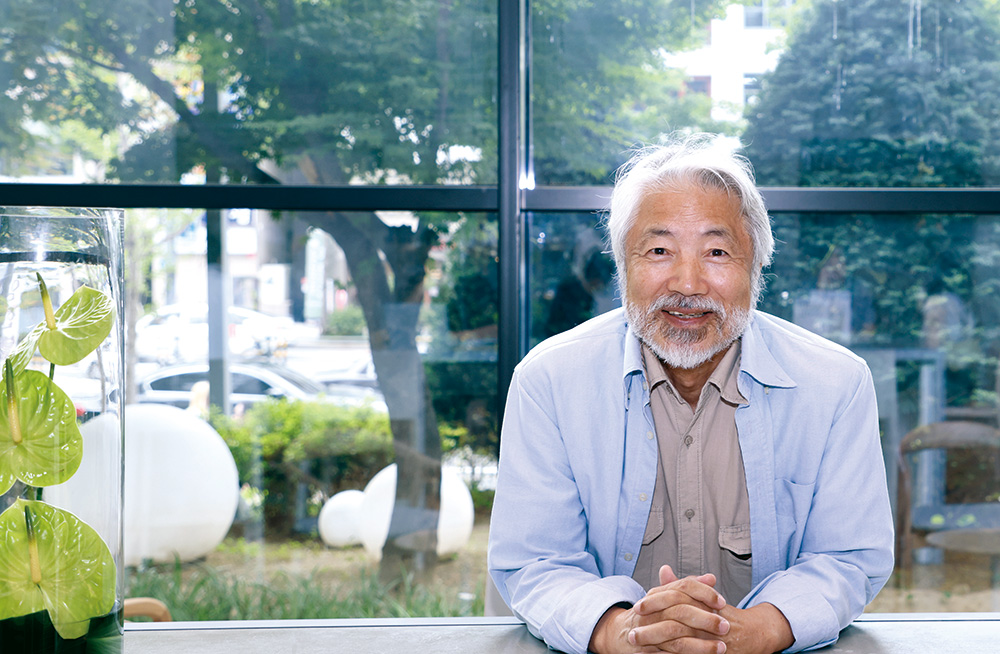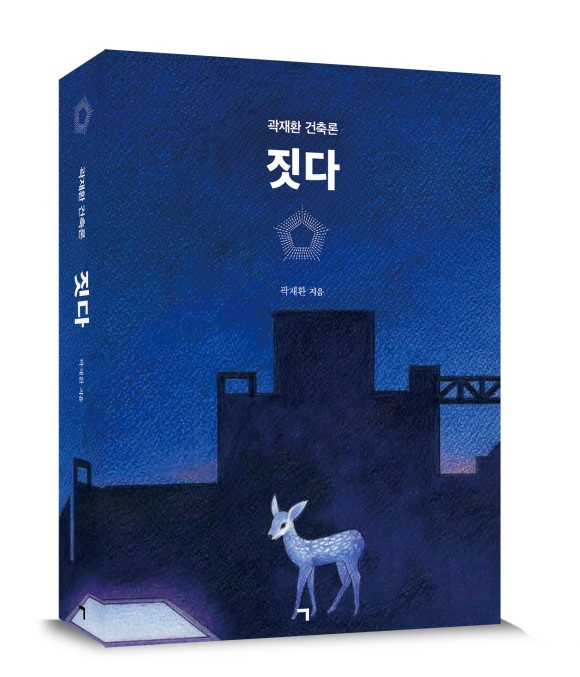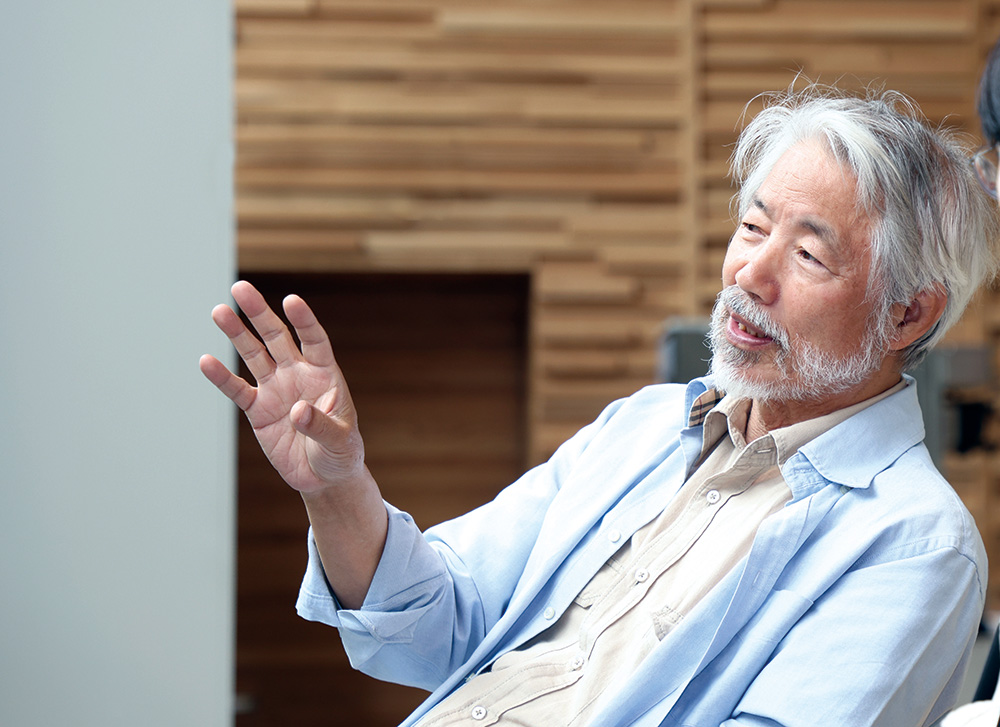2024. 7. 31. 11:00ㆍ아티클 | Article/인터뷰 | Interview
“Architecture is the Art of Space and Time, We Must Illuminate Architecture Shaped by Long Periods”


“ 건축과 삶의 합일을 뜻하는 아가일여(我家一如) 건축 설계로 구현한 삶·앎·놂·풂·빎, 아가오장(我家五場) 반세기를 통과한 건축적 시간 저서 ‘짓다’에 담아 ”
곽재환 건축사의 저서 ‘짓다’는 세상에 빛을 보기까지 20여 년이 걸렸다. 초고를 썼던 지천명의 저자는 이제 종심(從心)에 다다랐다. 마음이 하고자 하는 대로 따라도 그것이 법도를 벗어나지 않는다는 종심의 의미처럼, 곽재환 건축사는 무르익고 더 깊어진 사고로 ‘짓다’를 새로 지었다. 50여 년 동안 건축적 시간을 통과해 온 곽재환 건축사의 시간은 ‘아가일여(我家一如)’로 귀결됐다. 그가 아가일여에 담고자 했던 의미는 무엇이었을까.
“아가일여는 건축과 삶의 합일을 말합니다. 건축과 삶이 하나가 될 때 집과 집에 머무는 사람이 일치한다는 의미입니다. 아가일여의 근간은 삶, 앎, 놂, 풂, 빏으로 정의한 아가오장(我家五場)입니다. 제가 진행했던 건축 설계도 이 다섯 가지에 사유에 기반해 진행됐습니다. 사유의 출발은 무덤이었습니다. 살아있는 사람이 머무르는 내부 공간이 건축의 필요충분조건이라면, 피라미드는 왜 건축으로 분류되는지 의문이 들었습니다. 피라미드와 우리의 봉분이 다른 바는 또 무엇이고요. 그렇게 짓고, 만드는 것, 나아가 건축에 대한 고민이 오랫동안 계속됐습니다.”
곽재환 건축사는 소요와 응시를 통해 동적이고 정적인 인간 행위의 다양한 층위를 설계에 담아내왔다. 저서 ‘짓다’는 그가 가진 다섯 가지 철학의 기반과 실제 구현된 작품의 연결을 통해 그의 세계를 심도 있게 보여준다. 건축에 하늘을 담아내려는 그의 지향점은 자연과 건축물을 이으면서도 아름다움을 잃지 않는다.
“건축물의 규모, 용도와 관계없이 하늘은 제 건축의 핵심 주제인 만큼 건축 공간에 하늘을 담아내려 했습니다. 이러한 의도를 누구에게 드러내거나 설득하려 한 적은 없습니다만, 저는 지속적으로 건축 안에 하늘을 담고자 노력했습니다. 김중업건축연구소 시절부터 이후의 작품들, 지금까지 작업한 모든 건축이 제가 의도하며 추구했던 하늘을 향한 열정과 지향이 담겨 있다고 말할 수 있습니다. 제가 건축사사무소의 명칭을 맥(MAC, Message in Architecture to Cosmos)이라 정한 것도 하늘에 이러한 메시지가 닿길 바란다는 의미에서입니다. 더불어 맥은 숨을 뜻하는 순우리말이기도 합니다. 여러모로 제 지향점과 이어지는 단어입니다.”
이러한 사유를 바탕으로 곽재환 건축사는 건축 후학 양성에도 적극적이다. 20여 년째 학생들을 만나며 건축에 대한 관심과 창의성을 높이면서도 다양성을 추구하는 방안을 고심하고 있다. 한국 건축 흐름에서 빼놓을 수 없는 4·3그룹의 일원으로 활동하며 다양한 건축 담론을 논했던 그는 현재 한국 건축에 대해 어떻게 생각할까.
“개인적으로 한국 건축 비평이 활성화 돼야 하고, 건축 내부에서만 칭찬과 격려를 하지 말고 다른 장르의 사람들과의 교류를 통해 확장성을 가져야 한다고 봅니다. 미학, 인문, 철학, 산업, 경제적 측면 등 다른 분야의 눈으로 건축의 다양한 측면을 조명해야 합니다. 때로는 비평이 아니라 통렬한 비판이 필요하기도 합니다. 무엇보다 건축은 시공간 예술입니다. 준공 직후에 반짝일 때 촬영해 기록하는 게 아니라 오랜 시간이 빚어낸 건축을 조명해야 합니다. 처음에만 반짝이다가 시간이 흐를수록 추하게 변하는 건축물도 많습니다. 그러다보니 피상적인 것을 추구하고 본질보다는 포장에 치중하게 되는 거죠. 건축이 시공간 예술이라는 것을 기억하길 바랍니다.”

“ Agailyeo (我家一如), the unity of architecture and life Agaojang (我家五場), Sam(live)·Am(know)· Nom(play)·Pum(solve)·Bim(pray) realized through architectural design The book ‘Build’ captures architectural time that has passed half a century ”
It took 20 years for architect JaeHwan Kwak’s book ‘Build’ to see the light of day. The author, who wrote the first draft at age 50 (Jicheonmyeong), has now reached the age of 70 (Jongsim). Just as the meaning of Jongsim―even if you follow what your heart wants, it is not against law, architect JaeHwan Kwak newly created a book ‘Build’ with mature and deeper thought. The time for architect JaeHwan Kwak, who has gone through architectural time for more than 50 years, has led to ‘Agailyeo’. What was the message he wanted to convey in Agailyeo?
“Agailyeo refers to the unity of architecture and life. When architecture and life become one, it means that a house and the people staying in the house become one. Agailyeo is based on Agaojang(我家五場), defined as Sam(live)·Am(know)·Nom(play)·Pum(solve)·Bim(pray). The architectural design I carried out was also based on these five philosophies. The starting point of these thoughts was the grave. If indoor space where alive people reside is a necessary and sufficient condition for architecture, I wondered why pyramids are classified as architecture. What is the difference between the pyramids and our burial mounds? “I spent a lot of time thinking about building and making in this way and even architecture for a long time.”
Architect JaeHwan Kwak has captured the various layers of dynamic and static human behaviors through ramble and gaze in his designs. His book ‘Build’ provides an in-depth look at his world through the connection between the basis of his five philosophies and his actual works. His aim to capture the sky in architecture connects nature and architecture without losing beauty.
“Regardless of the size or purpose of the building, the sky is the core theme of my architecture, so I tried to embody the sky in architectural space. I’ve never tried to reveal this intention or persuade anyone to do so, but I have continuously attempted to embody the sky in architecture. I can say all the architecturural works I have worked on since I was at Mokchon Architecture Archive (Kim Chung-up) embody my passion and aim for the sky that I’ve intended and pursued. The reason why I named my architecture firm MAC (Message in Architecture to Cosmos) was because I hoped that this message will reach the sky. In addition, MAC is also a pure Korean word meaning breath. It is a word in line with my intention in many ways.”
Based on these reflections, Architect Jae-Hwan Kwak is also actively involved in educating future generations of architects. For over 20 years, he has been meeting with students, striving to enhance their interest and creativity in architecture while pursuing diversity. As a member of the 4•3 Group, which is indispensable in the flow of Korean architecture and engaged in various architectural discourses, what does he think about the current state of Korean architecture?
He said, “Personally, I believe that Korean architectural criticism needs to be more active. We shouldn’t just praise and encourage within the field of architecture, but should expand through interactions with people from other genres. Architecture should be illuminated from various perspectives, including aesthetics, humanities, philosophy, industry, and economics. Sometimes, what is needed is not just criticism but severe critique. Above all, architecture is the art of space and time. We should focus on architecture shaped by long periods, not just capturing it in its initial, sparkling moment right after completion. Many buildings that initially shine become ugly over time. As a result, we end up pursuing superficial aspects and focusing more on appearances rather than essence. I hope we remember that architecture is the art of space and time.”
인터뷰 곽재환 Kwak, Jae-Hwan 칸 건축사사무소(주)
글 조아라 기자
사진 장영호 기자
'아티클 | Article > 인터뷰 | Interview' 카테고리의 다른 글
| 아이 엠 키라_"소통하는 열린 설계로 건축주와 건축사 모두의 만족 이끌어내" 강병석 건축사 2024.7 (0) | 2024.07.31 |
|---|---|
| [건축담론] 150년 역사의 독일 건축설계 대가 규정과 한국 건축계의 미래를 위한 시사점 2024.7 (0) | 2024.07.31 |
| “건축은 시대적 산물…건축문화 발전 위해서는 건축주 역할 중요해” 건축사 차태권 2024.7 (0) | 2024.07.31 |
| “제약·규제보다 공동체 행복 고민해야,그럴 때 건축사 철학 담은 작품 활동 가능” 건축가 야마모토 리켄 2024.7 (0) | 2024.07.31 |
| [인터뷰] "좋은 공간 위한 건축언어 고민, 공동운영체제로 유연하고 다양한 해답 찾는다" 정태권 건축사 2024.7 (0) | 2024.07.31 |
